India's first train to be developed and designed locally to match international standards while addressing the peculiar problems of the city's crush-hour commute, has retired from the tracks and been sold for scrap.
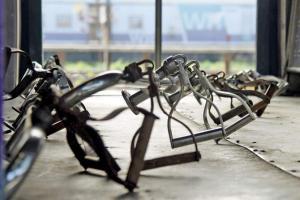
.
The Mumbai local had not seen a massive makeover since the 1960s. Until the early years of the new century, as commuter numbers on Western Railway (WR) crossed 30 lakh, the existing local trains running on two lines between Borivli and Virar, were bursting at the seams. With practically no time for maintenance, the health of the rakes took a toll and the Churchgate to Virar ride would leave the fittest commuter drained. The boxy nine-car rakes, packed to the brim, could accommodate only 2,628 commuters. The lucky would get to rest their behinds on the hard 876 wooden seats, while about 1,752 passengers stood. It was a tiring two-hour ride.
After the city shut down its well-established tram network in 1964, it didn't develop an alternative, depending entirely on the suburban railway system run by the Indian Railways, a central government body whose priority was always the national network. This led to saturation, strangulating the suburban network, with no time for upgrades. It's only at the turn of the century that funds started coming in from international banks, and the Mumbai Railway Vikas Corporation (MRVC), a think-tank and rail body set up to upgrade the city's rail infrastructure, channelised the growth of both, WR and CR in a planned manner.
In 2005, things took a turn when MRVC implemented phase one of the World Bank-funded Rs 4,500 crore Mumbai Urban Transport Project to improved the age-old design of the Mumbai local.
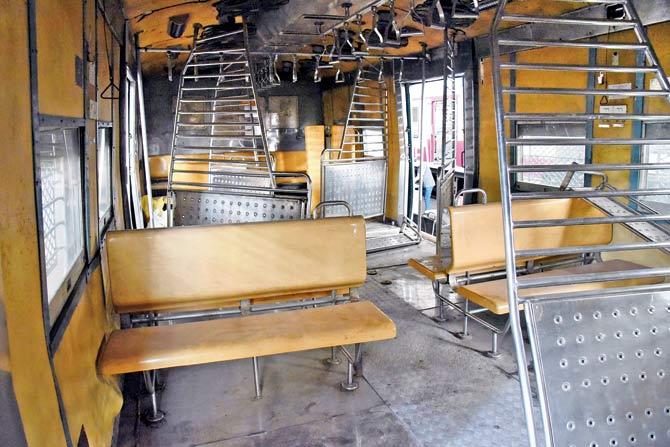 The interiors of the Millennium rake, introduced to Mumbai in 2005, were taken apart in November 2019, and the train was dismantled and sold for scrap in Pardi, Gujarat, last month
The interiors of the Millennium rake, introduced to Mumbai in 2005, were taken apart in November 2019, and the train was dismantled and sold for scrap in Pardi, Gujarat, last month
Even as senior engineers at the Integral Coach Factory (ICF) at Perambur near Chennai—until then the sole manufacturer of local trains used in Mumbai, Chennai, Hyderabad, Kolkata, Howrah and Delhi,—brainstormed, WR took on the ambitious challenge of designing a new state-of-the-art train internally at its Mahalaxmi workshop. For the first time, attention was paid to innovation in design influenced by the peculiar challenges that trains running on the Mumbai suburban railway network faced, including dense crush hour loads and three-minute frequency runs. They took a 10-year-old rake and upgraded it with the best available material locally, adopting UIC standard codes to bring it up to speed with international standards. Union internationale des chemins de fer (UIC) is a global rail transport industry body that plays an important role in the standardisation of railway parts, data and terminology, in trains across the world.
WR's goal was to upgrade the age-old passenger interface, introducing amenities like Forced Air Ventilation, Passenger Information System (PlS), graphic signage (as against language-based ones), 32 hi-sweep fans instead of 24 and paint-less interiors. The painted wood panels were replaced by steel panelled walls, adding a shiny look and feel. The driving cab was redesigned for the first time with an aerodynamic design and made crew-friendly. It included a bigger cabin, a touch screen for trouble shooting, a wider lookout glass for better visibility, regulated lighting and fans, an electronic buzzer for signal and emergency. With the GPS facility, the electronic LCD display installed in the train informed passengers about the oncoming stations and which side the platform would fall on. An automatic pre-recorded voiceover announced the name of the approaching station, a novelty in those days.

Right from the 1920s, local trains had been brown and dust yellow, the chocolate hue masking stubborn paan spittle. The nine-car rake was upgraded to 12 cars, and sported a violet and white look. "It remained the best train on the line till it served. The staff at the Mahalaxmi workshop had taken extra effort to remodel with finesse," remembers Ravinder Bhakar, WR's chief public relations officer.
This train (numbered 931-932) was entirely manufactured at WR's Mahalaxmi workshop at a cost of about two crore rupees and took over two years to build. Then railway minister Lalu Prasad Yadav had flagged it off with much fanfare from Borivli station on 17 October, 2005.
The date is insignificant, say rail enthusiasts, because it was for the first time in 30 years that a fully upgraded rake was being introduced into Mumbai. Naturally, commuters were excited. For Vijay Aravamudhan, it was love at first sight. The RBI officer, who travelled every day from Goregaon to CST and back, says, "There was not a single day before I took this train that I had managed to reach office without being drenched in sweat. This was an airy train, and the commute time was shorter."
Aravamudhan, and scores of commuters like him, bid the Millennium rake goodbye with a heavy heart when its retirement was announced in November 2019; the interiors were taken apart and the train sent to Pardi near Valsad in Gujarat where it was broken down entirely with cutting torches and the metal sold for scrap. They experienced a mix of loss and longing. It wasn't unwarranted nostalgia. The Millennium rake had laid the template for the rest of the country—this is how a suburban train should be. "We realised that if a rake design succeeded in Mumbai's extreme rush and weather, it could run in any part of the country," a senior railway official had once quipped.
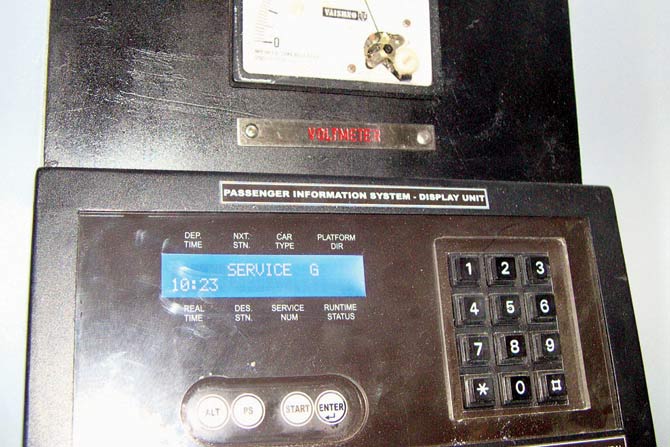 Passenger information system console inside the motorman's cabin
Passenger information system console inside the motorman's cabin
True to this claim, the rake became a national template for suburban services across the country.
"The Mumbai local train had sported more or less the same design since the 1960s, with minor tweaks. It's tedious to get any changes or upgrades effected in the railways since approval must come from the highest level, since it involves the safety of millions of commuters. Also, Mumbai commuters are vocal and protest changes if they don't like a new type of seating, leading to unnecessary litigation. So we had to approach the redesign cautiously. We improved the seats, offering greater leg room and the steel interiors made the train look brighter," a senior official, who had been with the Millennium rake team, told Sunday mid-day.
MRVC Director (technical), Ravi Agarwal, who was one of the original members of the Millennium rake team, recalls why it was a challenging dream project. "We realised we were up against severe limitations. We did research to compare EMUs across the world on how best to incorporate features of global trains into our train. Many of the features [of the Millennium rake] were introduced by the Indian Railways for the first time. It became a benchmark for all rakes to be manufactured at that time under MUTP by MRVC."
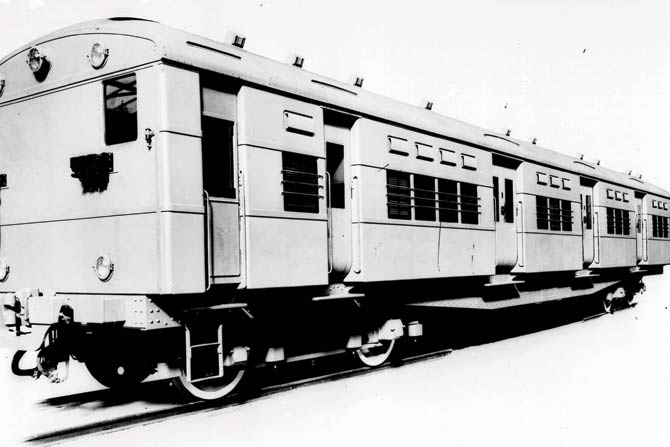 The first coach that arrived in Mumbai in 1925
The first coach that arrived in Mumbai in 1925
Mumbai's fascination with train coaches began in the 1920s. Between 1921 and 1925, the city's docks were choc-a-bloc with a new type of coach—metal boxes with wood-panelled interiors and peculiar iron rods on their heads. Twelve feet wide, the third-class compartments had as many as 96 seats each. Made by Cammell Laird and Waggonfabrik Uerdingen AG (German rail vehicle manufacturers), they became a wonder as they were transported in batches on the railway lines and assembled into units of four coaches each. Newspapers of the day boasted that the era of clean trains had arrived and there would be lesser smoke and pollution as compared to traditional steam trains. These were the first set of electric trains that India had ever seen and Mumbai—then Bombay—was the city in the country where they were introduced as locals. With this, India became the 24th nation in the world and the third in Asia, to have an electric railway system.
.jpg) A local train from the 1930s approaching Churchgate
A local train from the 1930s approaching Churchgate
The first electric local train ran on the Harbour line on February 3, 1925, between Bombay VT and Kurla. Subsequently, these trains took over all the rail lines, becoming the city's lifeline.
In 1928, trains were procured from Cammell-Laird (British rail wagon manufacturer). These were used on WR till the 1970s. A few Hitachi and Nippon trains were used on the Central Railway line in the earlier days and a few from SIG Switzerland in the 1950s. The Birmingham Railway Carriage and Wagon Company supplied 56 coaches in the early 1950s and later from Metropolitan Cammell, which were used until the early 1980s. In the 1960s, trains from Jessop Kolkata and Integral Coach Factory (ICF) were brought into service. The ICF originally began building trailer coaches in 1962 and motor coaches in 1963. Over the years, minor tweaks were made to the original design. And though manufacturing had begun in India, it was largely without innovation.
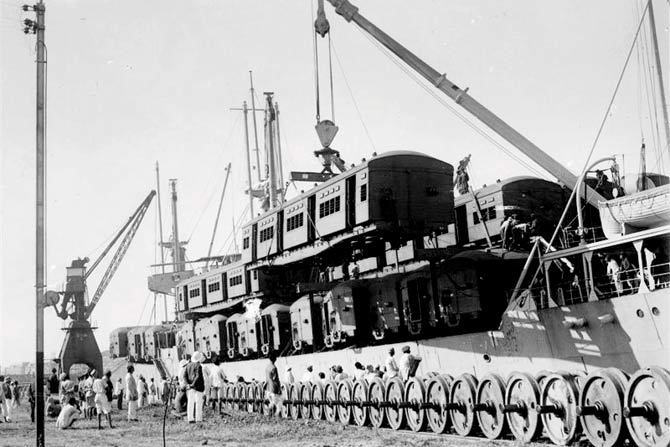 An electric local arriving in Mumbai at the docks in the 1930s. The metal boxes had wood-panelled interiors
An electric local arriving in Mumbai at the docks in the 1930s. The metal boxes had wood-panelled interiors
Which is why the Millennium rake represents in a sense, the coming-of-age for the Indian Railways.
The new-age Siemens local, built by the ICF on the template of the Millennium rake, arrived in Mumbai by 2007 and the first train was put in service in November that year. Today, the more advanced Bombardier-class locals have taken over and the dream is to convert that humble old Mumbai local into an air-conditioned crowd buster.
Getting new local trains for the city was not an easy task. "These were new-age, high-end trains with software from Germany and wheels from Austria. It was a sort of a global combo package. There were the little things [to take care of] like getting custom clearance for the parts being imported, coordinating with the Germans who provided the software. It was a big responsibility," recalls Dr Pramod Chander Sehgal, senior officer of the 1973 batch of the Indian Railway Service of Electrical Engineers, who played an instrumental role as managing director of MRVC, in his book on Project Management for Mumbai suburban railway.
 Commuters get off a local train at Churchgate station in 1957. Pic courtesy/ Western Railway Archives
Commuters get off a local train at Churchgate station in 1957. Pic courtesy/ Western Railway Archives
"I had to coordinate with 40 bodies, including the World Bank, every single day to implement the railway component of the Rs 4,500 crore Mumbai Urban Transport Project and, believe me, it is not easy."
The local trains manufactured by the ICF thus, became a national template for suburban services across the country with similar trains running on the local networks in New Delhi, Kolkata, Hyderabad and Chennai. In fact, additional and older local trains from Mumbai's fleet have been sent to other cities, where the extremities and risks are lower. The famed Churchgate local that had once dashed the buffer-end and jumped the station is now running smoothly in Howrah, thanks to the new aerodynamic design.
The role of foreign firms in the evolution of the city's suburban railway network has been limited to providing electrical equipment and motors, whether the Siemens or Bombardiers. The earliest Indian Railway trains were of British design and the manufacturers came from all countries that Britain had industrial relations with.
 Vijay Aravamudhan, an RBI officer, travelled every day from Goregaon to CST and back on the local. He says until the arrival of the Millennium rake, “there was not a single day that I had managed to reach office without being drenched in sweat.” Pic/ Shadab Khan
Vijay Aravamudhan, an RBI officer, travelled every day from Goregaon to CST and back on the local. He says until the arrival of the Millennium rake, “there was not a single day that I had managed to reach office without being drenched in sweat.” Pic/ Shadab Khan
The latest challenge for the Indian Railways is to convert its train fleet into air-conditioned, with closing doors. WR has a fleet of six AC locals while CR has one. WR seems to be winning the round as against CR mainly for one reason—the AC locals are taller and unable to pass under the old British-era bridges that criss-cross the CR network. The ICF has now come up with a shorter version of the train for CR. It is the shortest among them all, fixed at a height of 4,270 mm as compared to the original 4,283 mm ones that run on WR.
Mumbai's suburban railway network is the busiest commuter train system, with eight million people using the trains to commute daily. Annually, the suburban railways transport 2.95 billion passengers, which is about a third of the world's population. Due to the extensive reach of Mumbai Suburban Railway across the Mumbai Metropolitan Region, and its use by the urban population, it suffers excessive overcrowding. Over 5,000 passengers are packed in a 12-car rake during peak hours as against the rated carrying capacity of 3,600. Also, most of the stations are old and congested. Work to enhance capacity has begun, but the system is saturated for now. A project has been initiated to increase length of the trains to 15 coach and introduce cab signalling to reduce the distance between two trains.
 Arpan Mitra, bank officer
Arpan Mitra, bank officer
New trains will continue to be introduced in a city that has never stopped growing, but for Arpan Mitra, 29, a bank officer, the Millennium rake will always remain the superstar of Direct Current local trains. Because, Mitra says, it maintained its uniqueness despite the launch of new generation trains like Siemens, Bombardier, Medha and BHEL that came after it. "It will be remembered as Mumbai's star train. It is sad to see it go like this [in scrap]. At least one of the coaches could have been saved to display at some museum and keep the memory of this iconic rake alive."
Mumbai surburban rly in numbers
- More than 400km of tracks
- More than 8 million passengers daily
- More than 3,027 train trips per day
- More than 270 12-car trains (3,243 coaches)
- Present headway of approx. 3 min 48 sec on fast line and 3 min 36 sec on slow corridors
Evolution of Mumbai suburban railnetwork
1925
4-car
1927
8-car
1961
9-car
1986
12-car
2009
15-car (WR)
2017
AC local (WR)
Catch up on all the latest Mumbai news, crime news, current affairs, and also a complete guide on Mumbai from food to things to do and events across the city here. Also download the new mid-day Android and iOS apps to get latest updates
 Subscribe today by clicking the link and stay updated with the latest news!" Click here!
Subscribe today by clicking the link and stay updated with the latest news!" Click here!









